
Граматика / English Syntax
.pdf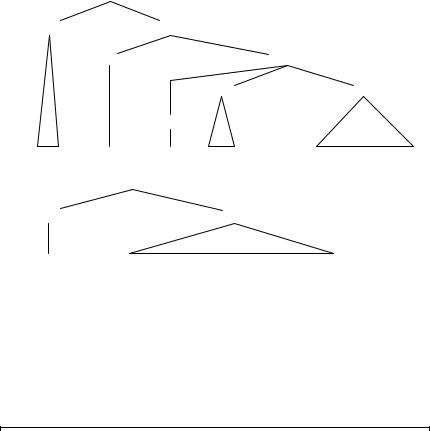
66 |
More on Form: Clauses and Sentences |
|
|
to use triangles (sometimes called clothes-hangers). We use these when we are not interested in the structure of a particular constituent. Using triangles we can also represent (51) as in (55), or as in (56):
(55)S/MC
NP |
|
VP |
|
|
|
V |
|
|
SubC |
|
|
|
NP |
VP |
|
|
Comp |
|
|
Tim |
thought |
that |
Kate |
believed the story |
(56) |
S/MC |
|
|
|
NP |
|
|
VP |
|
Tim |
thought that Kate believed the story |
|||
The tree in (55) only takes up marginally less space than the one in (51), however. Another, more e ective, way of saving space in representing syntactic structure is by using labelled bracketings, which were introduced in Section 4.1. These, however, su er from the disadvantage that they can be di cult to read. It is important to realise that labelled bracketings are a di erent way of representing syntactic structure, but they are otherwise equivalent to phrase markers.
Exercise
‘Translate’ the following labelled bracketings into phrase markers (cc ¼ coordinating conjunction).
(57)[AP [AP old] [cc and ] [AP useless]]
(58)[NP [NP a computer] [cc and ] [NP a keyboard]]
(59)[AP [AP pretty stupid] [cc and ] [AP quite eager]]
(60)[VP [VP likes tea] [cc and ] [VP hates co ee]]
(61)[PP [PP on the table] [cc and ] [PP in the cupboard]]
(62)[AdvP [AdvP wilfully] [cc and ] [AdvP mercilessly]]
(63)[S [S They arrived at 10 a.m.] [cc and ] [S They left at 6 p.m.]]
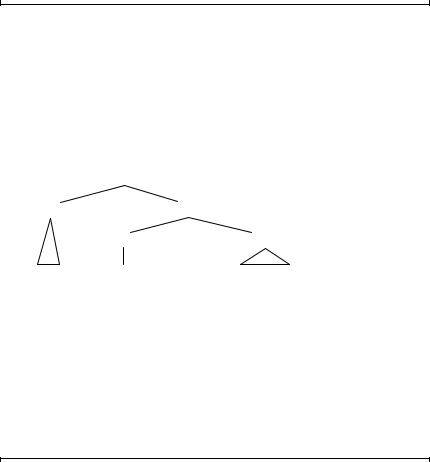
More on Tree Diagrams |
67 |
|
|
(64)[S [S We will not o er this student a place] [cc but ] [S We can recommend a College that will]]
To round o this section I will briefly discuss the question how the grammatical functions (GFs) of constituents in sentences are represented in tree diagrams. You may already have noticed that they aren’t. We will assume that functions can be ‘read o ’ tree diagrams by looking at the structural configuration of the constituents. The GF of Subject can then be defined as the NP immediately dominated by the S-node, notated as [NP, S], whereas the GF of Direct Object is the first NP immediately dominated by VP, notated [NP, VP]:
(65)S/MC
NP |
|
VP |
|
V |
NP |
Tim |
believed |
the story |
Let us now take a step back and see what we have achieved so far. In the last two chapters we took a preliminary look at the elements that make up sentences in English (words, phrases, clauses and sentences) and at the way these elements function. In this chapter the nature of these building blocks has been scrutinised in more depth. We also took a closer look at the way in which we can represent sentences in tree diagrams. The subject matter of the next chapter is to relate the function and form levels in a more systematic way than has been done so far.
Key Concepts in this Chapter
clause matrix clause
subordinate clause
finite clause, nonfinite clause the rank scale
tree diagram
declarative sentence/statement interrogative sentence/question imperative sentence/directive exclamative sentence/exclamation node
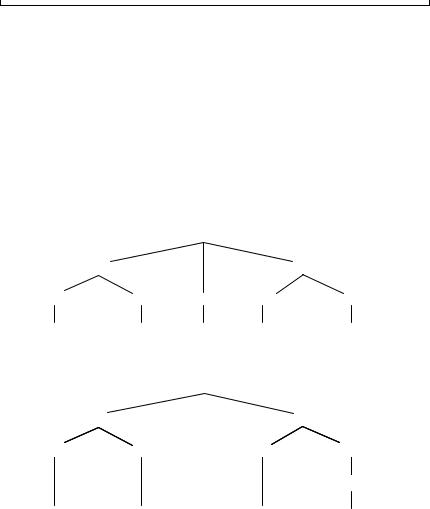
68 |
More on Form: Clauses and Sentences |
|
|
(immediate) dominance (immediate) precedence (immediate) constituent
Exercises
1.Consider the following sentence: I suggest that we have some lunch now. Are the statements below true or false?
(i)This sentence contains only one clause.
(ii)This sentence contains two VPs.
(iii)The DO of suggest is an NP.
(iv)The DO of have is an NP.
2.Produce labelled bracketings for the trees below. Underline the Heads.
a |
|
NP |
|
|
|
NP |
|
|
NP |
Det |
N |
cc |
Det |
N |
the |
cats |
and |
the |
dogs |
cc=coordinating conjunction |
|
|
||
b |
|
S/MC |
|
|
|
NP |
|
|
VP |
Det |
N |
|
V |
NP |
|
|
|
|
N |
this |
poison |
|
kills |
rats |
3.Identify the matrix clause and the subordinate clause(s) in the sentences below. Are the subordinate clauses finite or nonfinite?
(i)She believes that he is devious.
(ii)I made her laugh.
(iii)Sara concluded that Jamie heard that the story was untrue.
(iv)She wanted me to sell my bike.
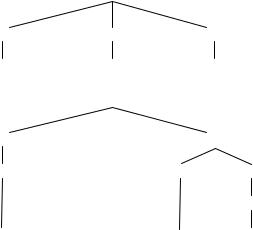
Exercises |
69 |
|
|
4.Using labelled bracketings, analyse the following sentences at the word, phrase, clause and sentence levels, as in Section 4.2. Then produce tree diagrams.
(i)The gira e ducked.
(ii)Television destroys relationships.
(iii)Freddy sent the doctor a postcard.
(iv)I believe that Geri adores gherkins.
(v)I know that Krum likes New York.
5.Assign the following sentences to one of the sentence types. Can they be used in situations other than the ones they are typically used for? Explain your answer.
(i)You may leave.
(ii)Could you be quiet, please?
(iii)Have a nice day!
(iv)This is a pavement! (said by an irate pedestrian to a cyclist using the pavement)
(v)Who likes right-wing dictators?
(vi)It’s so hot in here.
*6. Identify the correct tree diagram for the sentence in (i). What’s wrong with the other trees?
(i)Doctors cure patients.
a |
S/MC |
|
N |
V |
N |
Doctors |
cure |
patients |
b |
S/MC |
|
NP |
|
VP |
N |
V |
NP |
|
|
N |
Doctors |
cure |
patients |
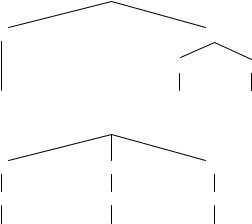
70 |
More on Form: Clauses and Sentences |
||
|
|
|
|
|
c |
S/MC |
|
|
N |
|
VP |
|
|
V |
N |
|
Doctors |
cure |
patients |
|
d |
S/MC |
|
|
NP |
VP |
NP |
|
N |
V |
N |
|
Doctors |
cure |
patients |
Further Reading
Sentence types, sometimes also called clause types, are discussed in Huddleston (1984), Chapter 11. See also Levinson (1983). Tree diagrams are found mostly in more theoretically oriented approaches to language. For further discussion in a somewhat di erent framework, see Radford (1988), Chapter 3.
5The Function–Form Interface
In the last three chapters we looked at the various components that make up sentences in English. We were concerned with two levels of analysis: first we examined the functions of the constituent parts of sentences. Then we investigated form, i.e. how the di erent elements in sentences combine into larger units. Remember that ‘function’ refers to Subjects, Direct Objects, Adjuncts, etc., and ‘form’ refers to words, word classes (noun, adjective, verb, etc.), phrases (NP, AP, VP, etc.), clauses (matrix clause, subordinate clause) or sentences. Because I dealt with function and form in separate chapters, you may have gained the impression that these levels of analysis are quite distinct and unrelated. Quite the contrary! The interrelationships between function and form are of immense importance in the study of syntax and a good grasp of the issues involved is essential to a proper understanding of sentence structure. Because the function–form interface is so important, I will devote an entire chapter to a detailed discussion of how we can link these two levels more systematically than we have done so far.
5.1Function–Form Relationships
Before turning to a discussion of the linguistic notions of form and function, let’s first consider the general notion ‘function’ in connexion with ordinary three-dimensional objects. Rather superficially, an observation we can make is that most objects perform a certain practical function. Consider, for example, a pencil. What is its function? Depending on the person you are, your circumstances, your interests, your profession, etc., you may give a variety of answers to this question. For example ‘writing’ (if you’re a student), ‘drawing’ (if you’re an artist), or perhaps ‘designing’ (if you’re an architect). Or take a rather more complex object, a personal computer. Again we might ask: what is its function? There is no uniform answer. We can use a computer for word processing, for making calculations, for sending e-mail messages, etc. Notice that as regards objects and the functions we can carry out with them, the reverse situation also holds: for most functions that we may want to perform, a variety of objects can be used. For example, the function ‘transportation’ can be performed by a car, a train, a bus, a boat, a bicycle, etc. The point is that there is no one-to-one relationship between a particular function (writing, drawing, word processing, etc.) and the object used (pencil, computer) to carry out that function.
71
72 |
The Function–Form Interface |
|
|
Having said that, of course it is true that there is often a salient function for any one object. For example, the salient function of bicycles is ‘transportation’.
For present purposes it is important to see that in language too there is a lack of a one-to-one relationship between the various forms we encounter and the functions they perform. The converse also holds: a particular function may be performed by di erent forms. This is why we need to distinguish between function and form.
It is time now to become a little more concrete and see what exactly is meant when we say that there is no unique relationship between form and function in language. In the remainder of this chapter I will discuss the several ways in which each grammatical function can be realised.
5.2Realisations of the Subject
Recall that we can identify the Subject of a sentence by asking ‘Who or what carried out the action denoted by the verb?’ and ‘Who or what is this sentence about?’ So, in a simple sentence like Fred eats his breakfast in bed we can identify the expression Fred as the Subject, because this NP refers to the individual who is doing the eating, and because the sentence can be said to be about him. We saw in Chapter 2 that this semantic characterisation of the notion Subject was not enough, and we therefore also characterised Subjects in terms of the kinds of syntactic structures they occur in. In most cases, however, asking the two simple questions above leads to a correct identification of the Subject.
In this section we will concern ourselves with the following question: which are the particular forms that Subjects can assume? When we discussed Subjects in Chapter 2 we saw that they are typically Noun Phrases:
NPs functioning as Subject
(1)[NP The hedgehog] ate the cream cake.
(2)[NP A rat] bit my toe.
(3)[NP This shoe] hurts me.
(4)[NP Academics] never lie.
However, Subjects can also be realised by other phrase types. Take the set of sentences in (5)–(8) where the Subjects are realised as Prepositional Phrases:
PPs functioning as Subject
(5)[PP Under the stairs] was a safe area to be during the war.
(6)[PP Outside the fridge] is not a good place to keep milk.
Realisations of the Subject |
73 |
|
|
(7)[PP After Saturday] would be a good time to go away for a few days.
(8)[PP Between eleven and midnight] suits me alright.
There are some restrictions on PPs as Subjects in English. Firstly, they are usually phrases that specify a location, as in (5) and (6), or time interval, as in (7) and (8). Secondly, the main verb of the sentence is often, though not exclusively (cf. (8)), a form of the verb be.
AP functioning as Subject
(9)[AP Restless] is what I would call him.
AdvP functioning as Subject
(10)[AdvP Cautiously] is how I would suggest you do it.
More common than PPs, APs or AdvPs as Subjects are clausal Subjects. Here are some examples of sentences with finite clauses as Subject.
Finite clauses functioning as Subject
(11)[That he will go to New York soon] is obvious.
(12)[Because he is generous] doesn’t mean that he is rich.
(13)[What the terrorists said ] puzzled the police.
(14)[Why she consented ] remains a mystery.
The bracketed Subject clauses in (11) and (12) are introduced by a conjunction, while those in (13)–(14) are introduced by a Wh-word, i.e. a word that begins with the letters wh, e.g. who, what, where, why, etc. (see Section 4.3.2). These clauses are called Wh-clauses. The syntax of Wh-clauses needs special attention, and we’ll therefore return to them in Chapter 9.
Nonfinite clauses too can perform the function of Subject. Recall from Chapter 4 that such clauses can be of five types: we have to-infinitive clauses, bare infinitive clauses, -ing participle clauses, -ed participle clauses and Small Clauses. Four of these types of clauses can perform the function of Subject: to-infinitive clauses ((15)–(26)), bare infinitive clauses (27), -ing participle clauses ((28)–(35)), and Small Clauses (36).
In (15)–(18), the to-infinitive clauses take a Subject of their own. This Subject is always preceded by for. In (19)–(22), the Subject clauses do not have their own Subject. To-infinitive clauses without Subject can be of two types: they are either not introduced at all, as in (19)–(22), or they are introduced by a Wh-word, as in (23)–(26), in the same way as in (13) and (14), except that this time we are dealing with verbs that do not carry tense.
74 |
The Function–Form Interface |
|
|
Nonfinite clauses functioning as Subject
To-infinitive clauses functioning as Subject with a Subject of their own:
(15)[For Judith to buy that house] would spell disaster.
(16)[For us to understand the issues] requires a major mental e ort.
(17)[For Janet to go to College] would be a good idea.
(18)[For Karl to visit art galleries] would not be desirable.
without a Subject of their own:
(19)[To be a good teacher] is more di cult than people think.
(20)[To see her] is to love her.
(21)[To surrender our arms] will seem cowardly.
(22)[To break down this fence] could lead to a conflict with the neighbours.
without a Subject of their own, introduced by Wh-word:
(23)[What to read during the holidays] is the question all students are asking.
(24)[Who to ask for permission] seems quite clear.
(25)[Where to sleep in this town] will not be an easy problem to solve.
(26)[Whether to teach grammar or not to schoolchildren] is a hotly debated issue.
Notice that where the Subject clause has no Subject of its own, one is usually implied and can easily be inferred. For example, in (19) the implied Subject of the bracketed clause is someone: For someone to be a good teacher is more di cult than people think.
Sentence (27) below is an example of a sentence that contains a bare infinitive clause as Subject. These are quite rare, and used informally. (28)–(35) instantiate Subject clauses in the form of -ing participle clauses, both with a Subject (in (28)–(31)), and without a Subject (in (32)–(35)):
Bare infinitive clauses functioning as Subject
(27)[Party the night away] is a nice thing to do.
-ing participle clauses functioning as Subject
with a Subject of their own:
(28)[Pete breaking the rules] is unacceptable.
(29)[Students walking on the roof ] poses a safety risk.
Realisations of the Direct Object |
75 |
|
|
(30)[Damien fooling around] embarrasses his friends.
(31)[George buying all those books] will cost his father a fortune.
without a Subject of their own:
(32)[Going on holiday] always creates tensions.
(33)[Running a business] is hard work.
(34)[Swimming in this lake] will make you ill.
(35)[Refusing to help the needy] is selfish.
As with the to-infinitive clauses, if there is no Subject, it can be inferred from the context or from one’s knowledge of the world.
We now turn to Small Clauses (SCs) functioning as Subject. You will remember from Chapter 4 that SCs are clauses without an overt verb, but in which the verb be is implied. SC Subject clauses are rare. They always have a Subject of their own, as the following example shows:
Small Clauses functioning as Subject
(36)[The kitchen free of cockroaches] is a welcome prospect.
5.3Realisation of the Predicate and Predicator
Recall that the Predicate in a sentence consists of everything but the Subject. Thus, in (37) Eric is the Subject and lost his keys yesterday is the Predicate. Inside the Predicate we distinguish the Predicator (the verb lose), the Direct Object (the NP his keys) and an Adjunct (the Noun Phrase yesterday):
(37)Eric lost his keys yesterday.
Predicates are Verb Phrases and Predicators are always main verbs. There is little variability as regards the realisation of Predicates and Predicators, but there is some, which we will deal with in Part IV of this book.
5.4Realisations of the Direct Object
Direct Objects are usually constituents which refer to an entity that can be said to undergo the action denoted by the verb. The way we put it in Chapter 2 was to say that Direct Objects typically have the semantic role of Patient. A simple way of determining what is the Direct Object in a particular sentence is to ask ‘Who or what is a ected by the action denoted by the verb?’ For example, in (37) if we ask ‘What is a ected by the process of
